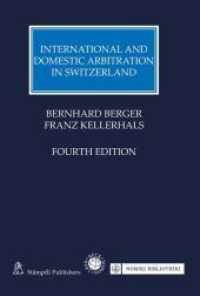- ホーム
- > 洋書
- > 英文書
- > Nature / Ecology
基本説明
Focusing on the niche field of metal ion toxicity in Quantitative Structure Activity Relationships (QSAR), this text concentrates on the basic and essential applications of QSAR methods in metal ions for readers already familiar with the field.
Full Description
Fundamental QSARs for Metal Ions describes the basic and essential applications of quantitative structure-activity relationships (QSARs) for regulatory or industrial scientists who need to predict metal ion bioactivity. It includes 194 QSARs that have been used to predict metal ion toxicity and 86 QSARs that have been used to predict metal ion bioconcentration, biosorption, and binding. It is an excellent sourcebook for academic, industrial, and government scientists and policy makers, and provides a wealth of information on the biological and chemical activities of metal ions as they impact health and the environment. Fundamental QSARs for Metal Ions was designed for regulatory and regulated organizations that need to use QSARs to predict metal ion bioactivity, as they now do for organic chemicals. It has the potential to eliminate resources to test the toxicity of metal ions or to promulgate regulations that require toxicity testing of metal ions because the book illustrates how to construct QSARs to predict metal ion toxicity. In addition, the book:
Provides a historical perspective and introduction to developing QSARs for metal ions
Explains the electronic structures and atomic parameters of metals essential to understanding differences in chemical properties that influence cation toxicity, bioconcentration, biosorption, and binding
Describes the chemical properties of metals that are used to develop QSARs for metal ions
Illustrates the descriptors needed to develop metal ion-ligand binding QSARs
Discusses 280 QSARs for metal ions
Explains the differences between QSARs for metal ions and Biotic Ligand Models
Lists the regulatory limits of metals and provides examples of regulatory applications
Illustrates how to construct QSARs for metal ions
Dr. John D. Walker is the winner of the 2013 SETAC Government Service Award.
Contents
Introduction. Electronic Structure of Metals and Atomic Parameters. Properties of Metals and Metal Ions Related to QSAR Studies. Descriptors for Organometallic Complexes. QSARs for Predicting Cation Toxicity, Bioconcentration, Biosorption, and Binding. QSARs versus BLM. Regulatory Limits and Applications. Constructing QSARs for Metal Ions.








